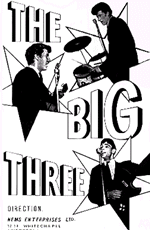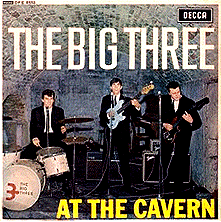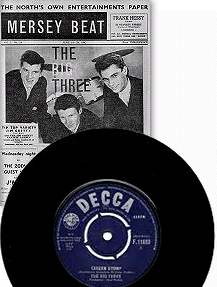|
Sixties
City presents
a wide-ranging series of
articles on all aspects of the Sixties, penned by the creator of the iconic
60s music paper Mersey
Beat
|
|||||
|
 |
A Liverpool
group who evolved from Cass and The Cassanovas, a four-piece band formed
in the late 1950s and were, for a time, regarded as the top group on Merseyside.
They even ran their own club, the Cassanova Club. The group was led by
Brian Casser, who used the names Casey Valence and Casey Jones. He was
a dynamic personality, adept at organisation.
They were a trio in 1959 comprising Casey Jones, Adrian Barber and Johnny Hutchinson, when Hutchinson brought Johnny Gustafson to see the group as they needed a bass guitarist. He was asked to join them, but couldn't play as he didn't actually own a guitar. Adrian converted a Hoyer Acoustic for him and put bass strings on it. On joining, he was commonly known as Johnny Bass, but later on was referred to as Johnny Gus. Leader and rhythm guitarist Cass left for London at the end of 1960, missing out on the entire Mersey success scene, although it has been suggested that the others pushed him out. The three remaining members of the Cassanovas stayed together and in January 1961 emerged as The Big Three. They were the first Merseyside group to play Ray Charles numbers and had a raw edge to their sound. Despite the fact that they were only a trio, they were one of the loudest bands on Merseyside, due to Adrian’s electronic wizardry. He made giant amps, standing over five feet tall, which were nicknamed ‘coffins.’ They were in big demand and The Beatles and other groups asked Adrian to make ‘coffins’ for them. The Big Three’s reputation locally was very high and, after signing The Beatles, Brian Epstein wanted the group in his ‘stable’, signing them after initially trying them out on a shared bill with The Beatles in Southport, and he sent them over to Hamburg on 1st July 1962. The German club insisted on quartets so Epstein arranged for Brian Griffiths, one of the most acclaimed guitarists in Liverpool, to join them. This eventually resulted in Adrian leaving the group and becoming stage manager at Hamburg's Star Club – he said he was never happy with Epstein managing them and they were supposed to be the Big Three not the Big Four. His suspicions about Epstein’s capabilities proved correct. |
 |
Brian arranged for them to audition for Decca and they recorded ‘Some Other
Guy’ - Gus was to tell broadcaster Spencer Leigh: “This was actually a demo
tape for Decca. My voice was completely gone. We’d come back from Hamburg
that very morning and were thrown into Decca’s No. 2 studio in the basement.
It was horrible. We were croaking like old frogs. Eppy wouldn’t let us do
it again and we went berserk. The bass sound was non-existent and the drum
sound was awful.” The group were appalled when they heard that Decca would be releasing their test recording and wouldn’t allow them a proper recording session to perform ‘Some Other Guy’ the way they wished it to be played. Also not understanding why The Big Three were so popular – because of their aggressive sound, their wildness, their casual appearance on stage – Brian also forced them to wear uniform suits and began to dilute their sound, choosing lightweight pop numbers and insisting, against their wishes, that they record Mitch Murray numbers, which were totally unsuitable for the group. Commenting to Leigh on the Decca recordings, Gus said: “It was arms up the back, ‘Do it boys, or it’s all over.’ We didn’t like it, but we tried our best. We hated ‘By The Way’ and ‘I’m With You’ because they were pop songs: poppy, horrible, three-chord Gerry and The Pacemakers type songs.” In 1963 their A&R man Noel Walker recorded them live at the Cavern. Decca engineers had spent three days experimenting with microphone positions and the recording took ten hours because of technical problems. The Big Three and Epstein officially came to a parting of the ways on 20th July 1963, but the damage had already been done. Before their EP ‘The Big Three at the Cavern’ was released on 22nd November 1963 there was dissension in the group. Johnny Hutch insisted he was leaving. Gus and Griff replaced him with Ian Broad, drummer with Rory Storm and The Hurricanes, and decided to call themselves The Seniors. They left for Germany, where they appeared at the Tanz club, Hamburg. Hutch approached Faron and Paddy Chambers of Faron’s Flamingos and asked them to join him. |
 |
 |
|
|
Article
Text
UK
web hosting by
|